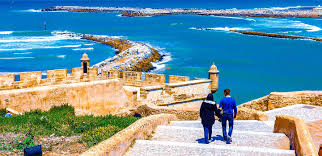Morocco is full of fascinating places to savor a good mint tea and forget about the routine. Today I would like to share what I consider my essential places to see in Morocco and that deserve not one but many trips. So take note and take into account this place so that you visit it in the company of the family, we begin ...
White House
It is the Hassan II Mosque, which, although from the end of the 20th century, is one of the most beautiful Islamic complexes that populates the African continent. It is raised over the sea on an artificial peninsula, it has a gigantic minaret 172 meters high and it is only surpassed in dimensions by the sacred sanctuary of Mecca. In fact, there are no less than 100,000 faithful if we add the interior of the building and the main courtyard. A wonder in which more than 10,000 artisans from the country intervened to work the ceilings, walls and columns with top quality materials.
Dadès Valley, karst territory
It is one of those gifts that geology has left in southern Morocco. The landscape variety opens its range to gorges and karst canyons, rocks with impossible shapes and a reddish hue that collides with the white of the peaks of the Great Atlas. In my case I was lucky enough to travel this winding road and during a month of January in which it began to snow. From the cliffs hang a good number of kasbahs and ksours whose adobe has weakened over the centuries. It can be considered the heart of the route of the kasbahs since the density of them is evident
Marrakech and the square of wonders
The life of this place, lit by the lavish Koutoubia mosque (sister of the Giralda of Seville) facilitates a safe encounter with toothpicks, casters, snake charmers (and what are not snakes), monkeys of the barbary, vendors of three to the fourth, preachers, letterheads, bohemians and a wide collection of open-mouthed tourists who do not believe what happens there.
Volubilis
This city founded by the Carthaginians in the 3rd century BC reached its maximum prosperity when it passed into Roman hands and the main monuments were erected that today can be seen within an immense complex of ruins also protected by UNESCO. Later in the 7th century, after a period of decline, Idrís I proclaimed himself emir, claiming to be great-grandson of Muhammad and Volubilis became the Islamic heart in this area of the Maghreb. Although with the Lisbon earthquake of 1755 it was destroyed and many of its buildings were looted to raise a new Meknes, it has remains of great importance such as the Basilica and the Temple of Jupiter, the Forum that completely structured the city, some ancient hot springs, an arch dedicated to the Emperor Caracalla
Fez
suitable for those who enjoy getting lost in mazes. Because the medina of Fez is considered not only the largest in the Muslim world, but one of the most authentic. From the ancient Benimerin tombs it is possible to understand from the outside what this network of streets and alleys that do not end anywhere looks like and that seems to have been stranded in a distant time....
Rabat
It is the shy sister of the Moroccan imperial cities, even the least visited. And perhaps that is why Rabat ends up being one of the most attractive and surprising places for travelers to stay in Morocco. On the south bank of the Bu Regreg river just as it is about to flow into the Atlantic, a small medina of white houses emerges, full of authenticity and devoid of impersonal souvenir shops.
Ksar of Ait Ben Haddou, the Kingdom of heaven
The cities fortified by the Berbers are known by ksars or ksours, most with adobe walls, many of which are in southern Morocco (although there are also other countries in the Maghreb). It is easy to confuse and exchange this concept with that of kasbah, but by kasbah we mean a type of fortification that we could compare more closely with a castle.





.jpg)
No comments:
Post a Comment